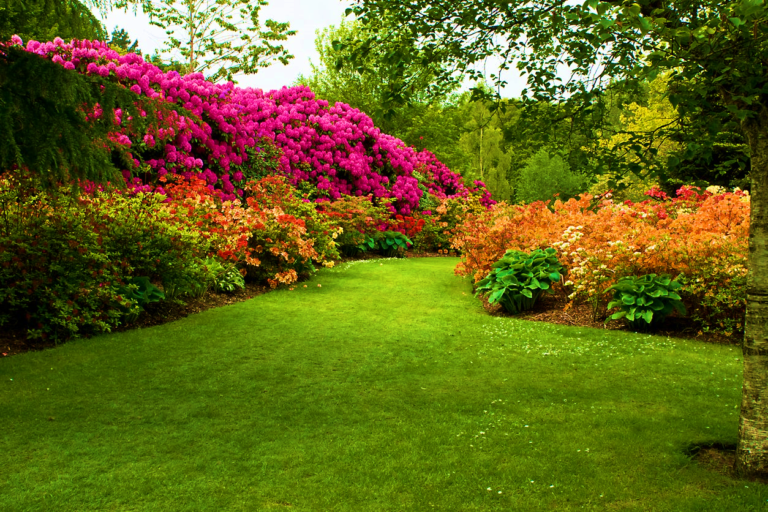What Makes Hydrangeas Blue, The Science Behind the Hydrangeas Blue
In the realm of horticulture, few flowers captivate the imagination quite like hydrangeas. Prized for their lush clusters and range of colors, these colorful and versatile flowers have blue as one of their most alluring tones. “What makes hydrangeas blue?” is a question that garden enthusiasts frequently ask themselves. The science of hydrangeas’ captivating blue tones reveals an intriguing journey involving plant physiology, soil chemistry, and the power of pigments.

The ability of hydrangeas to display a wide range of colours, from vivid pinks to deep blues and pure whites, is well known. The presence of a pigment known as anthocyanin holds the key. Many flowers, fruits, and leaves have red, blue, and purple hues because of anthocyanins. The particular colour that hydrangeas will display is largely dependent on the concentration and pH level of the soil.
How To Make A Hydrangea Change Color
Soil pH and the Alchemy of Color

The color-changing magic of hydrangeas begins with the soil they are planted in. The pH level of the soil directly influences the availability of aluminum, a key player in the color transformation process. Because of their special capacity to absorb aluminium from the soil, hydrangeas produce a visually stunning display of blue hues.
To achieve the coveted blue tones, hydrangeas require acidic soil with a pH ranging from 5.2 to 5.5. In acidic conditions, aluminum becomes more soluble and is readily absorbed by the plant’s roots. Once inside the plant, aluminum forms complexes with anthocyanin pigments, resulting in the formation of the blue coloration.
Conversely, alkaline soil with a pH above 6.0 inhibits the absorption of aluminum by the roots. Without sufficient aluminum, hydrangeas produce pink or red flowers, as anthocyanin pigments express themselves differently in the absence of aluminum. Understanding the delicate balance between soil pH and aluminum availability is crucial for manipulating hydrangea colors.
Hydrangea Varieties and Their Color Preferences

Not all hydrangea varieties respond to changes in soil pH in the same way. Different species and cultivars have distinct preferences for acidity or alkalinity, leading to variations in color expression. Some hydrangea varieties are more predisposed to producing blue flowers, while others lean towards pink or even shades of purple.
For example, the classic mophead hydrangea (Hydrangea macrophylla) is known for its chameleon-like nature, showcasing blue flowers in acidic soil and pink flowers in alkaline soil. Lacecap hydrangeas, another variation of Hydrangea macrophylla, often exhibit a mix of blue and pink tones on the same plant, creating a stunning and intricate display.
On the other hand, hydrangea species like Hydrangea quercifolia (Oakleaf hydrangea) and Hydrangea arborescens (Smooth hydrangea) tend to be less influenced by soil pH and generally produce white to cream-colored flowers. Understanding the specific preferences of the hydrangea variety you have is essential for achieving the desired color outcome.
Manipulating Hydrangea Colors

Gardeners who wish to manipulate the color of their hydrangeas can do so by adjusting the pH of the soil. This process involves amending the soil with substances that either increase acidity (for blue tones) or alkalinity (for pink tones). Here are some practical methods for achieving the desired hydrangea colors:
For Blue Hydrangeas:

Here are some practical methods.
Addition of Aluminum Sulfate:
This is a common method for increasing soil acidity and making aluminum more available to the plant. Gardeners can apply aluminum sulfate to the soil in spring or fall, following the recommended dosage on the product label.
Acidifying Fertilizers:
Using fertilizers specifically formulated for acid-loving plants can gradually lower the soil pH and enhance the availability of aluminum.
For Pink Hydrangeas

It’s important to note that the process of color manipulation may take time, and patience is key. Quick changes in soil pH can stress the plant, so gradual adjustments are recommended.
Lime Application:
Adding lime to the soil helps raise the pH level, making aluminum less accessible to the plant. This is a suitable method for gardeners aiming for pink or red hydrangea flowers.
Alkaline Fertilizers:
Fertilizers with higher pH levels can contribute to soil alkalinity, influencing the color outcome of hydrangea blooms.
Environmental Factors and Hydrangea Color

While soil pH is a primary factor influencing hydrangea color, environmental conditions also play a role. Factors such as sunlight, temperature, and moisture levels can impact the intensity and vibrancy of hydrangea colors.
Sunlight Exposure:
Intense Sunlight:
Hydrangeas that receive ample sunlight tend to produce more vivid colors. However, excessive sunlight can also lead to wilting and sunburn, so it’s essential to strike a balance.
Shade Conditions:
In shaded areas, hydrangeas may exhibit softer and less saturated colors. Some gardeners intentionally choose shaded locations to achieve a specific color effect.
Temperature:
Cooler Temperatures:
Hydrangea colors may appear more intense in cooler climates, contributing to the richness of the blooms.
Warmer Temperatures:
High temperatures can sometimes cause colors to fade or appear less vibrant. Adequate watering during hot spells can help mitigate stress on the plant.
Moisture Levels:
Consistent Moisture:
Hydrangeas thrive in consistently moist soil. Adequate watering ensures healthy plants and vibrant, well-hydrated blooms.
Drought Stress:
Prolonged periods of drought can lead to stress, affecting the overall health of the hydrangea and potentially influencing color expression.
The interplay of these environmental factors adds another layer of complexity to the art of cultivating hydrangeas with specific color preferences.
Conclusion
The enchanting blue hues of hydrangeas are a result of a delicate dance between soil chemistry, plant physiology, and the magic of pigments. Understanding the role of soil pH, aluminum availability, and the specific preferences of hydrangea varieties empowers gardeners to manipulate and showcase a stunning array of colors in their landscapes.
As nature’s own artists, hydrangeas invite us to explore the alchemy of color in our gardens. Whether aiming for the classic blue, soft pink, or pristine white blooms, the key lies in embracing the science behind hydrangea colors and applying it with care and consideration. In the world of horticulture, the mystery of what makes hydrangeas blue unveils a captivating journey of science, art, and the timeless beauty of nature’s palette.
FAQ’S
In soil with a pH below 6, flowers exhibit a blue hue. Conversely, in alkaline soil with a pH above 7, flowers showcase shades of pink or even red. When the soil is slightly acidic or neutral (with a pH ranging from 6 to 7), blooms may display a purple color or a combination of both blue and pink on a single shrub.
To uphold the necessary levels for achieving the desired blue coloration in hydrangeas with blue blooms, cultivators must consistently apply aluminum sulfate drenches to the potted medium. It’s crucial to strike a balance, as excessive watering with aluminum sulfate can lead to an excess of Al3+, which may be harmful and potentially fatal to the plant.
Certain hydrangea varieties exhibit blue or purple hues when cultivated in acidic soil, while they take on pink or red tones in alkaline soil conditions. Therefore, if you plant a beautiful blue lace cap or mophead hydrangea in a garden with neutral to acidic soil, it will consistently yield blue flowers each year.
Among the vibrant array of flowers, blue hues are often regarded as uncommon. While blue hydrangeas may not command the same visual attention as their pink counterparts, their distinctiveness and uniqueness add an intriguing allure.
Traces of cyanide are present in all parts of the Hydrangea plant. Ingesting it accidentally may result in symptoms such as shortness of breath, dizziness, fainting, and a rapid pulse. In severe cases of poisoning, convulsions and death could occur.


